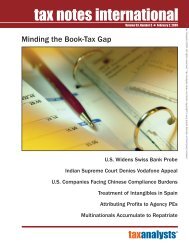deal structure note - Tuck School of Business - Dartmouth College
deal structure note - Tuck School of Business - Dartmouth College
deal structure note - Tuck School of Business - Dartmouth College
Create successful ePaper yourself
Turn your PDF publications into a flip-book with our unique Google optimized e-Paper software.
10<br />
Deal Structures Note<br />
Therefore, the Series A investor receives $2,000,000 / $0.30 – 4,000,000 = 2,666,667<br />
new shares:<br />
Owners/Investors Security Shares Investment<br />
Founders Common 6,000,000 $50,000<br />
A Convertible preferred 6,666,667 $2,000,000<br />
B Convertible preferred 10,000,000 $1,000,000<br />
In this case, the Series A investor now owns 29%, Series B owns 44%, and the founders<br />
retain 26%<br />
Pay-to-play (aka Play or Pay) Provisions are usually used with price-based antidilution<br />
measures, these provisions require an investor to participate (proportionally to<br />
their ownership share) in down rounds in order to receive the benefits <strong>of</strong> their antidilution<br />
provision. Failure to participate results in forced conversion from preferred to<br />
common or loss or the anti-dilution protection. This encourages VCs to support<br />
struggling portfolio companies through multiple rounds and increases the companies’<br />
chances <strong>of</strong> survival.<br />
OTHER ISSUES<br />
In addition to the key financial provisions described above, term sheets usually include a<br />
number <strong>of</strong> other important items related to control, and a mix <strong>of</strong> financial and nonfinancial<br />
terms is common. Many <strong>of</strong> the provisions described in this paper, both financial<br />
and non-financial, tend to be used more <strong>of</strong>ten during difficult economic times. It should<br />
be <strong>note</strong>d that overly burdensome, shortsighted terms may misalign interests and invite the<br />
competition to provide a better <strong>deal</strong>. Some non-financial terms are discussed below:<br />
Voting Rights. Term sheets <strong>of</strong>ten address issues <strong>of</strong> control in order to allow investors in<br />
a company to add value and also to exercise control if things go wrong. While investors<br />
may not want majority board control if things are going well, they may negotiate<br />
provisions that give them control if certain events occur. The golden rule <strong>of</strong>ten applies:<br />
he who has the gold makes the rules.<br />
Board Representation. Venture capitalists may negotiate control <strong>of</strong> part <strong>of</strong> the Board <strong>of</strong><br />
Directors, generally to influence decision-making and to protect their investments rather<br />
than to run the company. Often, classes <strong>of</strong> stockholders are allowed to elect a percentage<br />
<strong>of</strong> the board members separately. If venture capitalists invest as a syndicate and board<br />
representation is not possible for all <strong>of</strong> the participating firms, then board observer rights<br />
are an option. These rights allow investors to monitor their portfolio companies and to<br />
influence decisions by being present at board meetings, but they are not allowed to vote.

















